Could this be the most significant Nato since the Cold War?


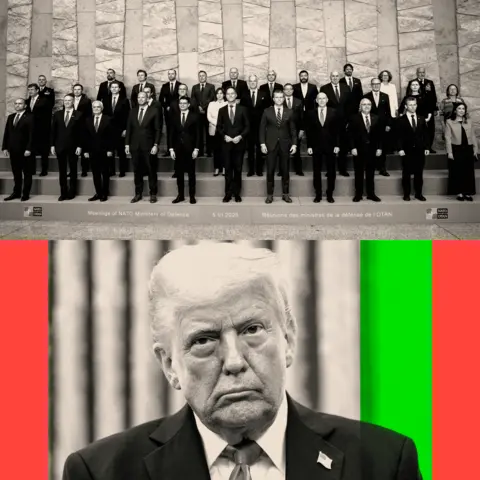 BBC
BBCAs the world holds its breath to see what happens next after the US launched direct attacks on Iran’s nuclear sites, US President Donald Trump is expected in the Netherlands on Tuesday for a Nato summit.
This will be Trump’s first Nato meeting since being re-elected. In the past, he’s made angry comments about alliance members freeloading off US security guarantees. European allies are desperate to prove him wrong. They hope to persuade him not to pull troops or US capabilities out of the continent.
“Relations with Europe have been so strained since Trump returned to the White House – over trade tariffs and more – that a few weeks ago, we weren’t even sure he’d turn up to this summit,” one high level diplomat – who spoke on condition of anonymity – told me.
“With Russia and China watching for western weakness, that would have been a disaster.”
But Moscow and Beijing may yet be able to bring out the popcorn.
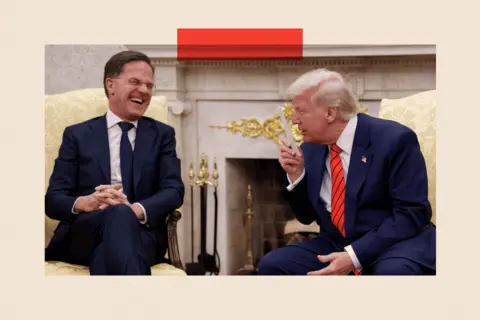 Getty Images
Getty ImagesNato’s secretary general Mark Rutte designed this summit around Trump. He aimed to flatter him by agreeing massive hikes in defence spending, to show that Europeans would now take more responsibility for their own security.
Rutte also hoped that by keeping the meeting narrowly focused on money, he’d avoid any potential clashes or outbursts between Trump and his allies.
That carefully-laid plan could be crumbling.
Now that Iran has launched missiles at US airbases in Qatar and Iraq in response to Saturday’s strikes on its nuclear sites, the US commander-in-chief may decide to remain in the Situation Room in Washington.
If he does come to Europe, as expected, how will it be possible not to talk about the Middle East considering what’s at stake? That would introduce the risk of a fallout between the US President and European allies, who advocated diplomacy over bombing when it came to Iran.
Trump loves a win and he’s very thin-skinned. He won’t want to feel any disapproval at the Nato meeting.
Separately, he’d been assured of a headline-grabbing victory at the summit, with European countries committing to spending a whopping 5% of GDP on defence – exactly as he demanded in his first weeks back in the White House.
“This summit is about credibility,” is how the US ambassador to Nato, Matthew Whitaker, puts it.
But Spain claimed on Sunday that it had secured an opt-out from the new spending plan – something Rutte later denied.
Other allies in Europe that are struggling to find the extra cash are bristling too.
The bottom line is: Europe needs to keep big military and nuclear power US onside. That’s how Rutte managed to corral reluctant leaders – bar Spain – into signing up to the new big spending push. It’s a massive commitment.
But as the former US ambassador to Nato, Julianne Smith, told me – even then, there are absolutely no guarantees with Trump.
 AFP via Getty Images
AFP via Getty ImagesIt’s unclear if the US would sign up to an end-of-summit declaration this week identifying Russia as the main threat to the Nato alliance.
Europe’s trust in the US as its ultimate protector has been shaken by Trump’s seemingly softly-softly approach with Moscow, and by his heavy-handed pressure on Kyiv, as he’s tried to end the war in Ukraine.
Additionally, on Friday night, you could almost hear European diplomats grinding their teeth, after Trump blithely justified the enormous 5% defence spending target he’s demanded of allies, while exempting himself and the US from the commitment.
“I don’t think we should, but I think they should,” he said. “We’ve been supporting Nato so long… So I don’t think we should, but I think that the Nato countries should, absolutely.”
Then again, Europe’s leaders arguably should have been better prepared by now in terms of self-defence.
He may be the bluntest and most unpredictable, but Trump is by no means the first US president to want to move military attention and investment from Europe to other priority areas, particularly the Indo-Pacific. President Obama was very clear about that back in 2011.
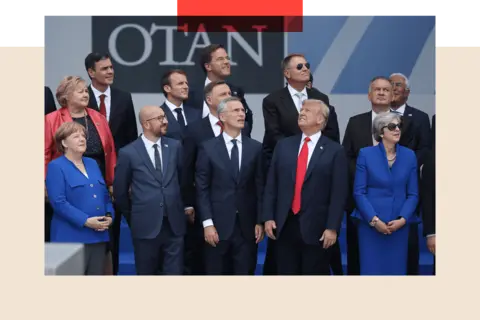 Getty Images
Getty ImagesThe US has nuclear weapons stored in Italy, Belgium, Germany and the Netherlands. It has 100,000 battle-ready troops stationed across Europe, 20,000 of them in Eastern European Nato countries, sent there by President Biden after Russia’s full-scale invasion of Ukraine.
The continent could make up a shortfall in troop numbers, especially with Germany and Poland planning to significantly build up their ground forces over the next few years. But Europe’s dependency on the US goes deeper, says Malcolm Chalmers, deputy director-general of the Royal United Services Institute.
It has relied on Washington for intelligence gathering, surveillance, air force capabilities and command and control. The US has performed a pivotal leadership role in Nato, bringing its members and forces together.
These are exactly the capabilities that are scarce and needed by the US military in Asia, says Mr Chalmers. If removed from Europe, they’d take a very long time to replicate.
Not long ago, many Nato countries in Europe avoided building up continental capabilities, such as extending France’s nuclear umbrella to other allies, for fear the US might say: “Oh well, you no longer need us. We’re off!”
But now, Europe is being forced to shoulder more security responsibility, not only to try to persuade Washington to stay – but also in case the US president decides to withdraw from Europe to a greater or lesser extent.
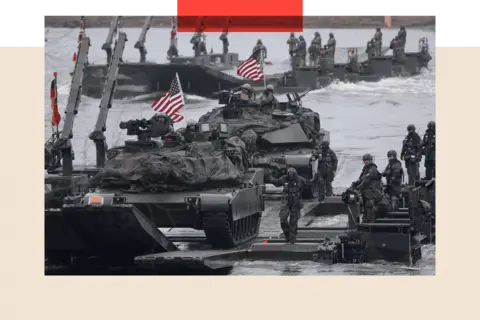 Getty Images
Getty ImagesNo one knows what Trump’s intentions are. Europe’s Nato leaders were hugely relieved recently, when his administration announced that US Air Force Lieutenant General Alexus Grynkewich would assume the traditionally US-occupied Nato position of Supreme Allied Commander, Europe. That implied commitment to the defence alliance.
But Washington is carrying out its own military spending and defence review. Announcements are expected in autumn. It’s thought unlikely there’ll be any new US funding for Ukraine. And very likely that the 20,000 extra troops in eastern Europe will be the first US forces to be pulled out of the continent.
Despite this, Poland says it will attend this week’s Nato summit in a confident mood. In stark contrast to Spain, Warsaw believes it’s leading by example – spending more of its national income on defence (currently 4.7% of GDP) than any other Nato member, including the US. It aims, it says, to build the most powerful land army in Europe.
During the Cold War, Poland lived under the shadow of the Soviet Union. The country neighbours Ukraine. It’s not hard to persuade Poles that defence is a top priority.
For politicians in countries further away from Russia, the argument is more challenging. Spanish media has been full of speculation that disagreements over defence spending could topple the country’s precarious coalition government.
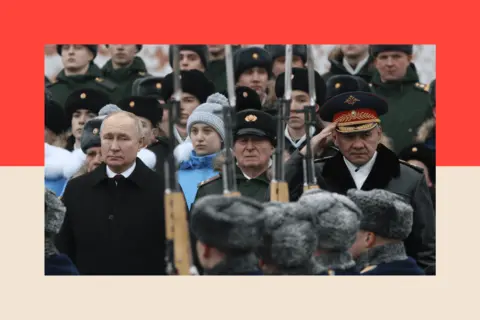 Getty Images
Getty ImagesTrying to both placate Trump by agreeing to his defence spending demands, while also sweetening the pill for more cash-strapped European leaders, Nato is proposing to split the 5% target into two parts: 3.5% of annual national income on defence, with a further 1.5% of GDP to be spent on “defence-related” issues, like expanding cargo sea ports in the Netherlands, for example, or France investing in cyber security.
This has the added bonus of bringing Europe into line with US military spending of 3.4% of GDP – a huge psychological landmark, says Camille Grand, former Assistant Secretary General for Defence Investment at Nato and now defence expert at the European Council of Foreign Relations.
But however you play with the figures, we’re talking about governments having to spend billions more on defence. The money has to come from somewhere.
Either new taxes – a method Estonia has been trying out – or more borrowing, which will be hugely expensive for countries like Italy that already have large amounts of government debt. Another option is a reduction in welfare spending – known as “guns or butter,” or “tanks or pensions” economics.
With its Strategic Defence Review, the UK recently stressed to the public the need for more military spending, but Mr Chalmers says neither Downing Street nor most other European governments have fully prepared their electorates for the trade-offs that huge new defence investments will require.
The timetable for reaching the 5% target is key. Nato allies have called for a 7-10 year window. Nato’s Secretary General has suggested that could be too late. With Moscow’s economy very much on a war footing, Russia will be able to attack a Nato country within five years, he says.
Defending Europe isn’t just about how much governments spend. As important is what they spend their money on.
A big European weakness is that there are lots of duplicate and incompatible capabilities across the continent: reportedly 178 different types of weapon systems and 17 different makes of tanks in the EU alone, for example. Putting aside national defence contracts and pride, and pooling European resources in the name of efficiency, is yet another thorny debate that will likely be sidelined at this week’s summit.
So what definite outcomes can we expect?
That very much depends on the man arriving in the Netherlands on Airforce One.
Trump’s ambassador to Nato says the meeting could be historic.
“A watershed moment” is how another high-level diplomat put it to me – and possibly “the most significant Nato summit since the Cold War”: the moment Europe began to spend as much as the US on defence and to truly assume responsibility for its own security.
BBC InDepth is the home on the website and app for the best analysis, with fresh perspectives that challenge assumptions and deep reporting on the biggest issues of the day. And we showcase thought-provoking content from across BBC Sounds and iPlayer too. You can send us your feedback on the InDepth section by clicking on the button below.
Source link







